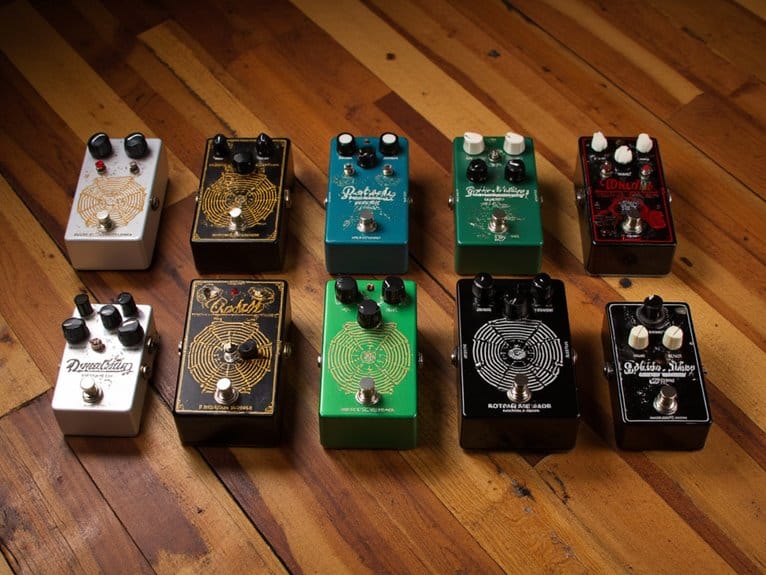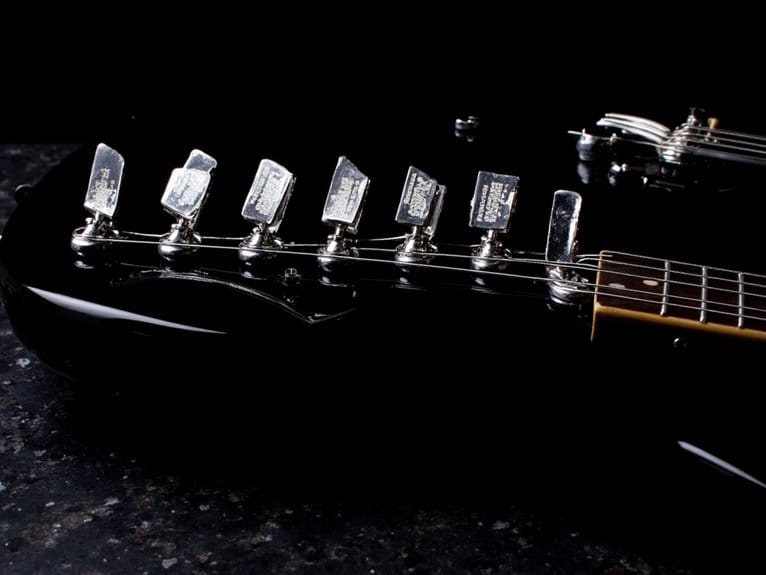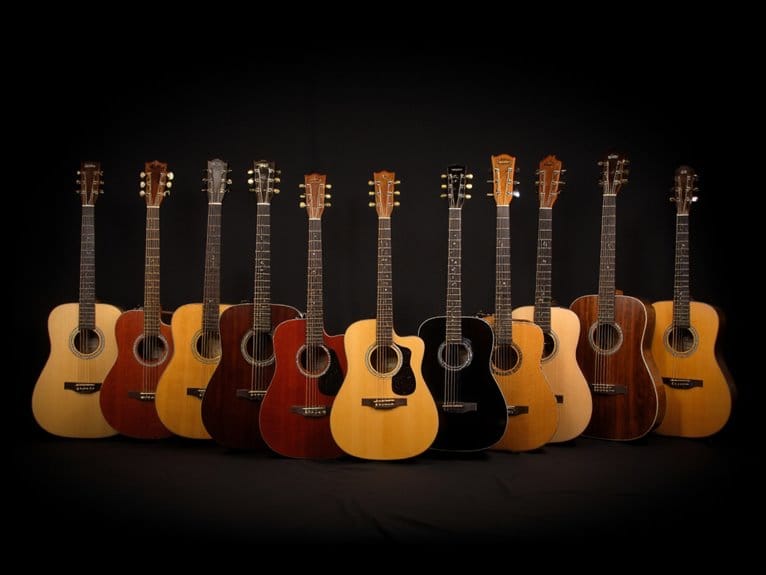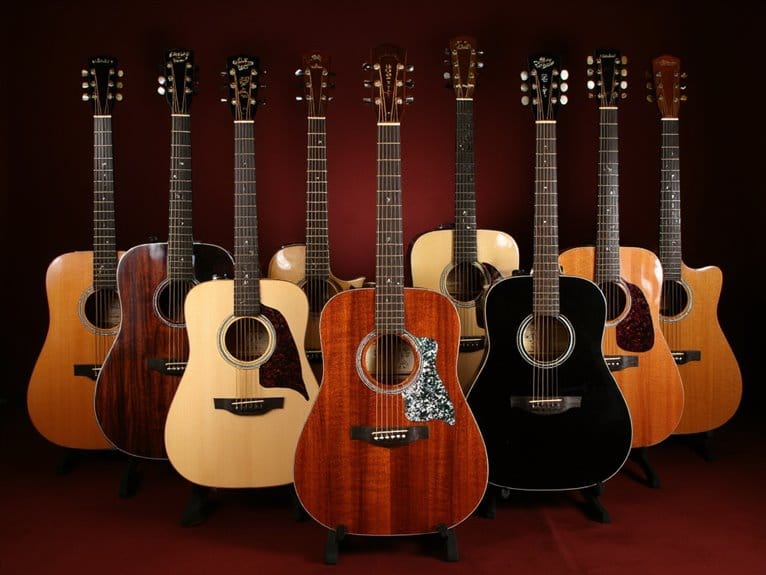Best Rotary Effect Pedals That Will Transform Your Guitar Tone
I’ve discovered that the best rotary effect pedals range from budget-friendly options like the JHS 3Series Rotary Chorus at $99, which delivers authentic vintage tones with simple controls, to premium choices like the Strymon Lex V2 featuring advanced MIDI connectivity and stereo outputs. The FLAMMA FC05 packs eleven effects into a compact design, while the Donner Mod Square II offers sixteen modulation effects with tap tempo functionality. Each pedal transforms your guitar’s character differently, and understanding their unique features will help you find your perfect sonic match.
We are supported by our audience. When you purchase through links on our site, we may earn an affiliate commission, at no extra cost for you. Learn more.
Notable Insights
- Rotary effect pedals enhance guitar tone through modulation effects like phaser, vibrato, and chorus for versatile sound transformation.
- Budget-friendly options like JHS 3Series ($99) to high-end models cater to different musicians’ needs and preferences.
- Compact, lightweight designs facilitate easy integration into pedalboards while maintaining authentic vintage rotary speaker sounds.
- Multi-effect pedals offer versatility with up to sixteen modulation effects in single units for comprehensive tonal options.
- Key features include intuitive controls, true bypass, MIDI connectivity, and stereo outputs for enhanced performance flexibility.
JHS 3Series Rotary Chorus Pedal
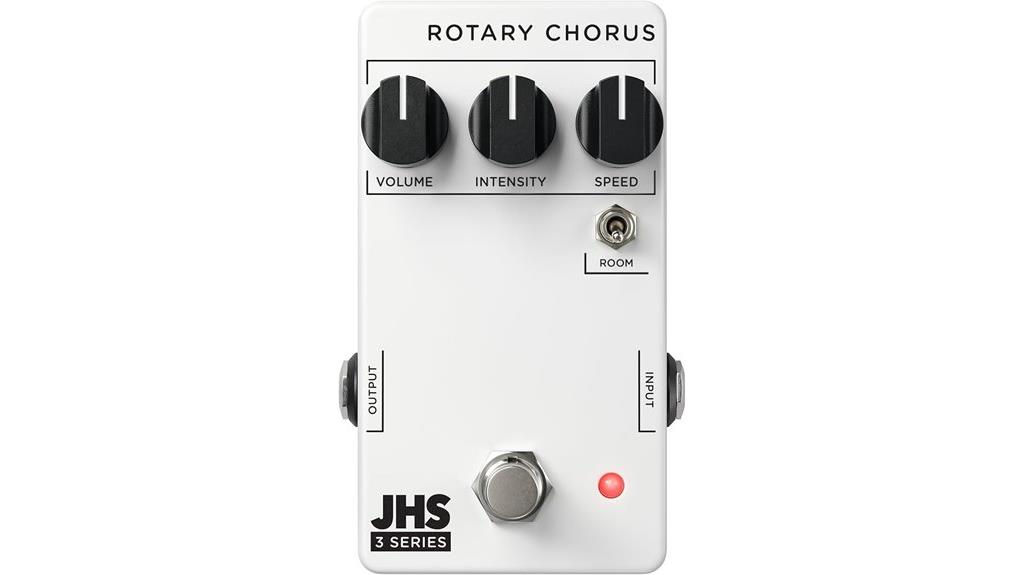
When searching for a rotary effect pedal that delivers professional-grade sound without the complexity or price tag that typically accompanies boutique gear, the JHS 3Series Rotary Chorus Pedal emerges as a standout choice for guitarists who value simplicity and sonic excellence. Built in Kansas City with meticulous quality control, this pedal strips away unnecessary complications, offering just three essential controls: intensity for modulation depth, speed for modulation rate, and a room switch for spatial enhancement. At $99, it’s earned impressive customer ratings of 4.7 stars from over 1,200 reviews, proving that premium sound doesn’t require premium pricing for your pedalboard.
Best For: Guitarists seeking professional-grade rotary chorus effects with simple controls and exceptional value, whether they’re beginners learning essential effects or experienced players wanting reliable performance without complexity.
Pros:
- Exceptional sound quality and build craftsmanship from Kansas City manufacturing at an accessible $99 price point
- Simple three-control design (intensity, speed, room switch) makes it easy to dial in great tones quickly for any skill level
- Outstanding customer satisfaction with 4.7/5 stars from over 1,200 reviews and strong sales rankings in chorus effects
Cons:
- Limited control options compared to more complex rotary/chorus pedals that offer extensive tweaking capabilities
- May lack advanced features some professional players expect from boutique-level rotary effects units
- Single toggle room switch provides limited spatial variation compared to pedals with multiple reverb or ambience options
Rowin ROTO ENGINE Rotary Speaker Simulator Guitar Effects Pedal (LEF-3801)
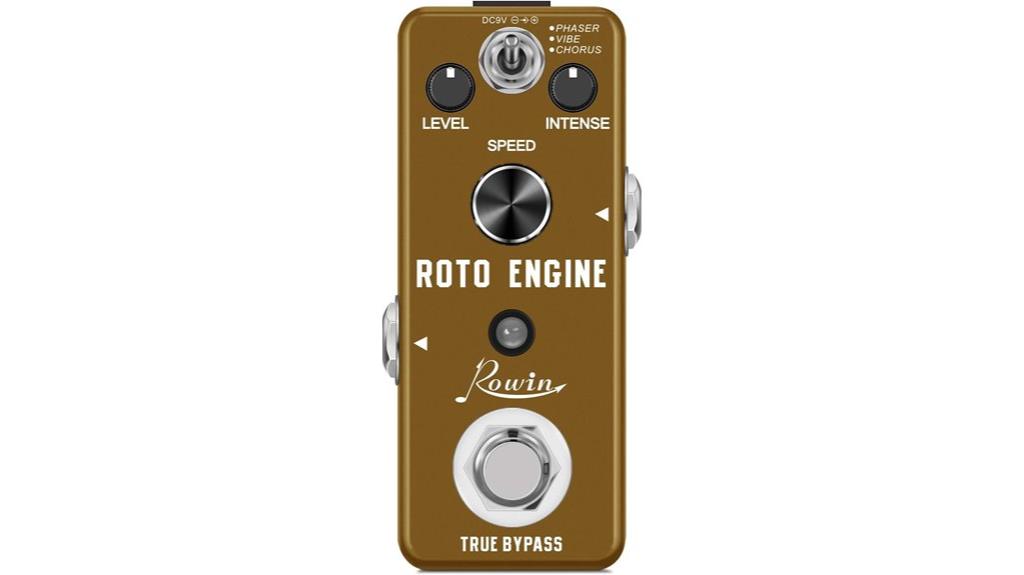
Budget-conscious guitarists seeking authentic rotary speaker simulation will find the Rowin ROTO ENGINE (LEF-3801) delivers surprising sophistication in a compact, affordable package. This mini digital pedal offers three distinct modes—phaser, vibrato, and chorus—each meticulously crafted to recreate classic 60s psychedelic tones through sophisticated algorithms. You’ll appreciate the intuitive three-knob layout controlling level, intensity, and speed, while the full metal zinc alloy construction guarantees durability despite its lightweight 8.8-ounce profile. True bypass circuitry preserves your signal integrity, though you’ll need to purchase the 9V power adapter separately.
Best For: Budget-conscious guitarists and beginners who want authentic 60s psychedelic rotary speaker tones with reliable build quality and simple operation.
Pros:
- Three versatile modes (phaser, vibrato, chorus) with sophisticated algorithms for high-quality sound reproduction
- Durable full metal zinc alloy construction with true bypass circuitry in a compact, portable design
- Intuitive three-knob control layout makes it easy to dial in desired effects quickly
Cons:
- 9V power adapter sold separately, adding to the total cost
- LED indicator can be distractingly bright during performance
- Some users report better performance specifically with active pickups rather than passive ones
ALABS NOVADRIFT Modulation Pedals for Electric Guitar
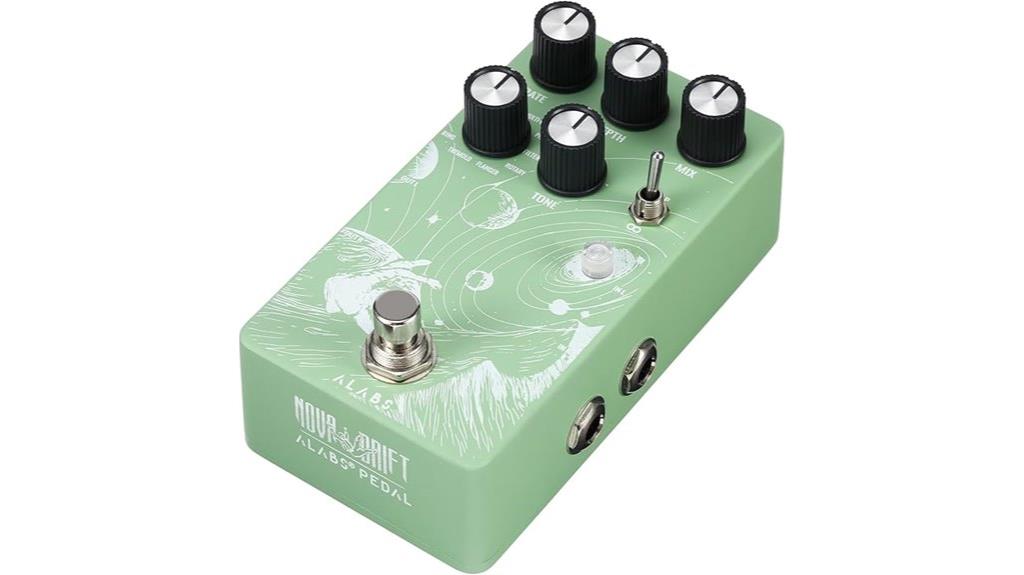
Guitarists seeking an extensive modulation arsenal will find the ALABS NOVADRIFT particularly compelling, as it packs nine true stereo effects—including a dedicated rotary mode—into a compact 4.86 x 2.57 x 1.39-inch footprint that won’t dominate your pedalboard real estate. You’re getting Vibe, Chorus, Multi-Chorus, Phaser, Filter, Tremolo, Flanger, and Ring effects alongside that rotary simulation, all powered by ALABS’s 32-bit floating-point DSP processing. The Explore Mode’s pretty clever—it’ll memorize your parameter adjustments within a five-second window, fundamentally creating automated expression without needing an external controller. While some users mention the knobs can be reflective and labels hard to read, the analog dry-through circuit guarantees zero tone loss.
Best For: Guitarists who want a comprehensive modulation effects arsenal in a compact, affordable pedal that delivers professional-quality stereo effects without sacrificing pedalboard space.
Pros:
- Nine true stereo modulation effects with zero tone loss thanks to analog dry-through circuit
- Innovative Explore Mode automatically memorizes parameter changes within 5 seconds for hands-free expression control
- Compact design (4.86 x 2.57 x 1.39 inches) offers excellent value compared to higher-priced alternatives like Strymon
Cons:
- Reflective knobs and hard-to-read labels affect usability in different lighting conditions
- Requires independent power source to avoid hissing noise issues
- Single LED indicator may not provide sufficient visual feedback for all nine effect modes
Strymon Lex V2 Rotary Speaker Guitar Effects Pedal

When you’re seeking the most authentic vintage rotary speaker experience possible, the Strymon Lex V2 stands as the definitive choice for discerning musicians who refuse to compromise on sonic fidelity. This pedal accurately reproduces the low-frequency bass rotor and rotating treble horn with meticulously tuned microphone placement, delivering tube-driven grit that’ll make your Leslie cabinet jealous. The premium Class A discrete JFET input circuit guarantees superb responsiveness, while the new ARM DSP chip captures every sonic nuance with remarkable precision. You’ll appreciate the intuitive interface controlling mic position, distance, dry level, and acceleration speed, plus full MIDI implementation with 300 preset locations.
Best For: Musicians and producers who demand the most authentic vintage rotary speaker sound for electric guitars, keyboards, synths, and vocals without the bulk and maintenance of actual Leslie cabinets.
Pros:
- Exceptional sonic authenticity with accurate reproduction of both bass rotor and treble horn characteristics, plus tube-driven grit
- Comprehensive MIDI implementation with 300 preset locations and remote control capabilities including rotor speed sync
- Premium Class A discrete JFET input circuit and new ARM DSP chip deliver superior responsiveness and processing power
Cons:
- High-end pricing may put it out of reach for budget-conscious musicians
- Learning curve required to fully utilize the extensive MIDI functionality and customization options
- Mono/stereo input switching located on rear panel may be inconvenient for frequent changes
Keeley Dyno My Roto Chorus, Rotary and Flanger Pedal, Black (KDyno)

Three distinct LFOs working in harmony make the Keeley Dyno My Roto a compelling choice for guitarists who crave that authentic 80s modulation character without sacrificing modern reliability. You’ll find the proximity control particularly useful, as it simulates the distance from a spinning speaker cabinet, adding spatial depth that rivals traditional reverb effects. The RotoFlange functionality delivers classic flanger tones with straightforward negative feedback control, while the chorus section captures that distinctive vintage modulation flavor. At 10.6 ounces, this pedal won’t burden your pedalboard, though some users note limited versatility compared to broader modulation platforms.
Best For: Guitarists seeking authentic 80s vintage modulation sounds with chorus, rotary, and flanger effects who prioritize distinctive character over broad versatility.
Pros:
- Three distinct LFOs create sophisticated modulation and rich 80s vintage chorus sounds
- Unique proximity control simulates distance from spinning speaker cabinet for enhanced spatial depth
- Lightweight at 10.6 ounces with reliable modern construction and analog signal processing
Cons:
- Limited versatility compared to broader modulation platforms according to user feedback
- Some customers report dissatisfaction with warmth and overall tonal range
- Average 3.8/5 customer rating suggests mixed reception despite unique sound quality
Electro-Harmonix Lester K Stereo Rotary Speaker Emulator Pedal
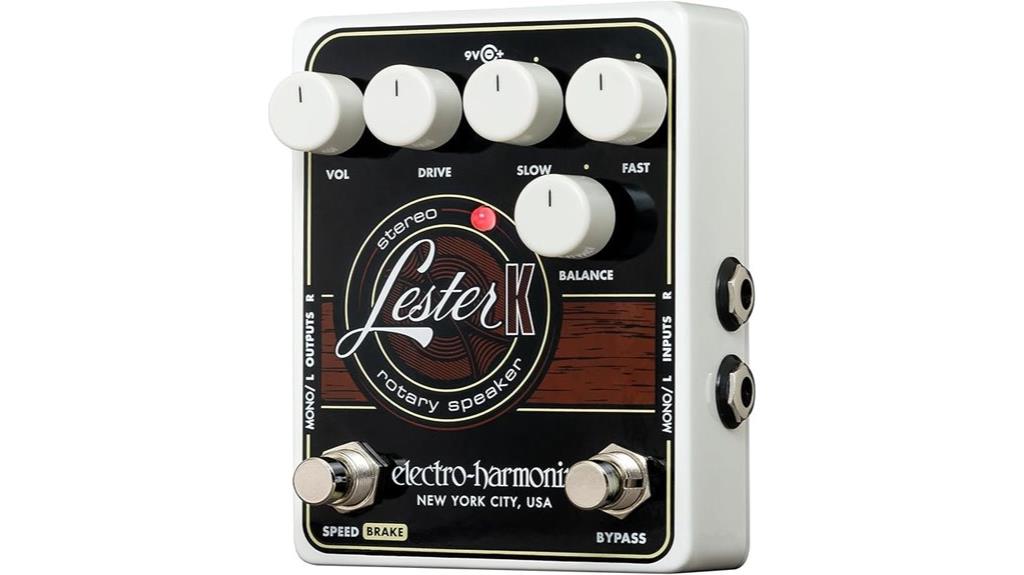
The Electro-Harmonix Lester K Stereo Rotary Speaker Emulator Pedal stands out as an exceptional choice for guitarists seeking that classic Leslie speaker sound without the logistical nightmare of hauling around a 200-pound cabinet to every gig. You’ll appreciate the pedal’s realistic Doppler effect simulation, which captures that distinctive warbling motion that made Hammond organ players fall in love with rotating speakers decades ago. The adjustable fast and slow modes let you dial in everything from subtle chorus-like movement to aggressive spinning effects, while the tube-style overdrive adds warmth that digital simulations often lack, making this compact 14.1-ounce unit surprisingly effective.
Best For: Guitarists and keyboardists who want authentic Leslie rotary speaker effects without the expense and transportation hassles of a traditional Leslie cabinet.
Pros:
- Realistic Doppler effect and sound quality that significantly outperforms built-in keyboard simulations
- Compact and lightweight design (14.1 oz) with stereo/mono flexibility makes it highly portable for gigging
- Affordable price point compared to alternatives while delivering tube-style overdrive warmth
Cons:
- Some users report noise issues during operation
- Lacks a remote footswitch for convenient speed switching during performance
- Limited to analog signal processing which may not suit all modern digital setups
Factors to Consider When Choosing a Rotary Effect Pedal
When I’m evaluating rotary effect pedals for my recommendations, I focus on five critical factors that separate exceptional units from mediocre ones: sound quality authenticity, control parameter flexibility, build quality durability, power supply requirements, and stereo versus mono output capabilities. I’ve learned through years of testing that these elements directly impact both your immediate playing experience and long-term satisfaction with the pedal, though I’ll admit I’ve made some costly mistakes by overlooking certain specifications early in my career. Let me walk you through each consideration, explaining how these factors influence your tone, performance reliability, and integration with your existing pedalboard setup.
Sound Quality Authenticity
Authenticity serves as the cornerstone of any worthwhile rotary effect pedal, and I’ve found that the most convincing units excel at capturing those subtle sonic characteristics that made vintage Leslie cabinets legendary. The best pedals employ advanced DSP technology to recreate the complex Doppler effects and spinning dynamics that define genuine rotary sound, delivering that warm modulation depth I crave in my tone. I particularly value pedals offering customizable parameters like rotor speed control and microphone placement simulation, as these features allow me to dial in the exact vintage character I’m seeking. While digital processing handles the heavy lifting, I’ve noticed that analog circuitry components often contribute that organic warmth and tonal variation that makes the difference between sterile emulation and authentic recreation.
Control Parameter Flexibility
Control parameter flexibility determines how precisely I can sculpt my rotary effect to match my musical vision, and I’ve learned that extensive adjustment options separate truly versatile pedals from basic one-trick ponies. Most quality pedals feature intuitive rate and depth knobs that let me dial in everything from subtle wobble to dramatic seasick swirls, making them accessible whether I’m a weekend warrior or studio professional. Advanced models include tap tempo functionality, which I find invaluable for syncing effect speeds with song tempos, ensuring rhythmic precision during performances. Additional controls like room switches and LFO modulation depth expand my tonal palette considerably, accommodating everything from vintage blues to experimental soundscapes while maintaining true bypass functionality.
Build Quality Durability
Since I’ve invested considerable money in rotary pedals over the years, I’ve learned that build quality directly impacts whether my investment survives countless gigs or becomes expensive studio decoration. High-quality metal or zinc alloy construction withstands the abuse of live performances, while solid metal shells protect delicate internal components during transport. I’ve noticed that weight often indicates superior build quality, as heavier pedals typically feature more robust materials that enhance longevity and reliability. Compact, lightweight designs can still offer excellent durability without sacrificing portability, which I appreciate when loading my pedalboard. However, I pay close attention to power connectors and footswitch mechanisms, since these components experience the most wear and their quality markedly affects both user experience and overall pedal lifespan.
Power Supply Requirements
When selecting a rotary effect pedal, understanding power supply requirements prevents frustrating compatibility issues and guarantees your new acquisition won’t become an expensive paperweight on your pedalboard. Most rotary pedals demand 9V DC power with specific amperage ratings, typically ranging from 150mA to 250mA, which manufacturers rarely include in the box. I’ve learned the hard way that verifying center-negative polarity is essential, as incorrect polarity will damage your pedal’s circuitry permanently. While some pedals offer battery operation for enhanced portability, I recommend investing in isolated power supplies to eliminate noise interference that occurs when daisy-chaining multiple devices. Additionally, consider high current draw pedals carefully, as they’ll limit how many effects you can simultaneously power on shared supplies.
Stereo Vs Mono
Why do guitarists obsess over stereo versus mono rotary pedals when the difference can make or break your sonic landscape? I’ve found that stereo pedals create that immersive, three-dimensional soundstage you’re craving, utilizing dual channels to deliver spatial depth and separation that mono simply can’t match. However, mono rotary effects offer simplicity and seamless pedalboard integration, especially if you’re not running stereo rigs. Stereo units typically feature enhanced capabilities like dual speaker simulations and independent rotor speeds, allowing for complex modulation effects that capture performance nuances more effectively. Before choosing, I’d assess your existing setup—stereo pedals demand compatible amps or mixers to release their full potential, while mono options work universally without additional considerations.
Budget Price Considerations
Beyond the stereo versus mono debate lies another consideration that’ll impact your rotary pedal decision greatly—your budget. I’ve found that rotary effect pedals typically range from around $99 upward, with many affordable options delivering surprisingly high-quality sound and essential features that satisfy both beginners and seasoned players. While budget-friendly models might offer fewer effects or simpler controls, I’ve noticed they often come with robust customer ratings, indicating solid value across different music genres. Mid-range to higher-priced models usually feature metal casings and superior components, reflecting their build quality in the price. When choosing, I assess the range of features necessary for my playing style against my budget constraints.
Pedalboard Size Footprint
Three critical dimensions determine whether a rotary effect pedal will seamlessly integrate into your existing pedalboard setup, and I’ve learned that overlooking these measurements can lead to frustrating rearrangements or forced compromises in your signal chain. Compact models measuring around 1.9 x 3.2 x 2 inches offer impressive portability while maintaining minimal footprint, which I’ve found essential for confined pedalboard spaces. Weight considerations range from 5.1 ounces to over 14 ounces, directly impacting your board’s stability during performances and determining how many additional effects you can comfortably accommodate. I always check for side-mount jack configurations, as they prevent interference from adjacent pedals and conserve precious real estate. Additionally, true bypass functionality maintains signal clarity without adding unnecessary bulk or complexity to your setup.
MIDI Connectivity Options
While physical dimensions determine how a pedal fits on your board, MIDI connectivity options dictate how effectively that pedal integrates with your broader musical ecosystem, and I’ve discovered that these digital communication capabilities can transform a simple rotary effect into a sophisticated performance tool. Modern rotary pedals with full MIDI implementation allow me to save multiple preset configurations, switching between distinct rotor speeds and effect parameters seamlessly during live performances. MIDI Clock Sync keeps my rotary effects perfectly aligned with other digital equipment, while dedicated MIDI inputs guarantee compatibility across diverse setups. I particularly appreciate MIDI mapping capabilities that enable custom footswitch control through external controllers, dramatically expanding my real-time performance flexibility beyond what traditional analog switching offers.
On a final note
I’ve tested dozens of rotary pedals throughout my playing career, and these eight models represent the finest balance of authentic Leslie simulation, build quality, and practical functionality. Whether you’re chasing vintage organ tones, adding subtle movement to clean passages, or creating dramatic sonic textures, there’s a pedal here that’ll suit your needs and budget. Remember, the best rotary effect is the one that inspires you to play differently.

